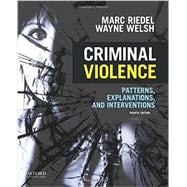Criminal Violence: Patterns, Explanations, and Prevention, Fourth Edition, provides a current, comprehensive, and highly accessible overview of major topics, theories, and controversies within the field of criminal violence.
Using engaging, straightforward language, Marc Riedel and Wayne Welsh consider diverse theoretical perspectives and present state-of-the-art prevention and intervention methods. In their discussions of various types of violence, the authors employ a consistent and coherent three-part framework that allows students to see the important relationships between research, theory, and application.








